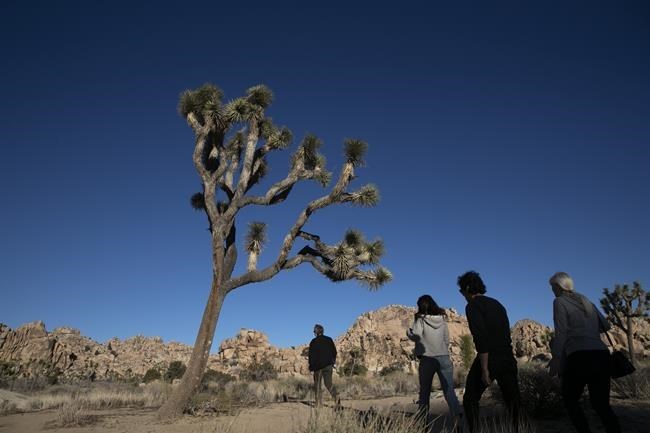SACRAMENTO, Calif. (AP) — California won't be listing the iconic western Joshua tree as a threatened species for now after the four-member Fish and Game Commission couldn't reach agreement Thursday on how best to protect the plant from climate change.
After deadlocking on whether to list the species under the California Endangered Species Act, commissioners decided to reconsider in October. In the meantime, they voted to pursue more feedback from tribes and directed the California Department of Fish and Wildlife to work on a conservation plan for the species.
The desert plant known for its unique appearance, with spiky leaves on the end of its branches, is found in the national park that bears its name about 130 miles (209 kilometers) east of Los Angeles and through a stretch of desert up to Death Valley National Park. There are two types of trees, the eastern and western, but only the western is up for consideration.
If the tree is listed as a threatened species, killing one would require special approval from the state. That would make it harder to remove trees to make way for housing, solar fields or other development projects. The trees are now under conditional protection while the state decides whether to deem them threatened, though some solar development projects have still been cleared to move forward.
The Center for Biological Diversity petitioned in 2019 to have the western Joshua tree listed as threatened, saying hotter temperatures and more intense periods of drought fueled by climate change will make it harder for the species to survive through the end of the century. It also argued wildfires and development threats harm the trees’ ability to live and reproduce.
The California Department of Fish & Wildlife said that areas suitable for the western Joshua trees growth are likely to decline due to climate change by 2100. But it said in an April report that the tree remained “abundant and widespread,” which lowers the risk of extinction. Staff recommended against listing the species.
The commissioners broadly agreed that climate change will put the species in danger over the coming decades. But they were split on whether the Endangered Species Act was the best way to address those concerns.
If the Joshua tree is listed as threatened, it would be the first state listing under the Endangered Species Act based primarily on climate change, said Brendan Cummings, conservation director for the Center for Biological Diversity.
Commissioner Erik Sklar said the act, which was designed roughly 50 years ago, may not be the best tool to deal with the effects of climate change.
“Listing in no way ensures survival,” Sklar said. “Protecting one species at a time the way we’ve been doing it feels like we’re fiddling while Rome burns.”
He pushed for the Department of Fish and Wildlife to work on a conservation plan. He further said the Legislature and governor should bring together everyone with a stake in the trees' future, including environmentalists, tribes and developers, together to come up with a plan for protecting the species.
But Commission President Samantha Murray said listing the species would not completely end development of housing or renewable energy projects. She voted to list, as did Vice President Erika Zavaleta.
“Listing doesn’t mean that there can’t be housing, that there can’t be renewable energy projects. It just means they’ll happen under a more careful watch,” Murray said.
It's unknown how many Joshua trees exist in the state, but it could be anywhere from 4.8 million to 9.8 million, said Jeb McKay Bjerke, of the Department of Fish & Wildlife.
About 40% of the Joshua trees in the state are on private land. Some local and state politicians and union workers said Wednesday listing the species as threatened would make it harder to move forward with necessary projects, including those that aim to fight climate change by boosting renewable energy. California has set a requirement that 100% of its electricity be produced from non-carbon sources by 2045.
San Bernardino County, where many Joshua trees grow, is also a prime location for solar development. The county recently increased the penalties for illegally removing Joshua trees — a $20,000 fine and six months in jail on the third offense.
Some of the Joshua tree growth areas that show the most promise for surviving despite the effects of climate change are on private land, said Cummings, of the Center for Biological Diversity.
Joshua trees already are not reproducing as fast as they once did and some research shows that by the middle of next decade it will be very hard for some young Joshua trees to survive, he said. Listing the species as threatened would help create plans for protecting them in key areas.
“The goal is not that no Joshua tree anywhere can be removed," he said. “The goal is that if we’re going to save Joshua trees, we need to map out and protect the areas where they’re most likely to survive."
The commission is supposed to have five members to avoid tie votes, but one stepped down in February. Gov. Gavin Newsom hasn't appointed a replacement.
Kathleen Ronayne, The Associated Press

